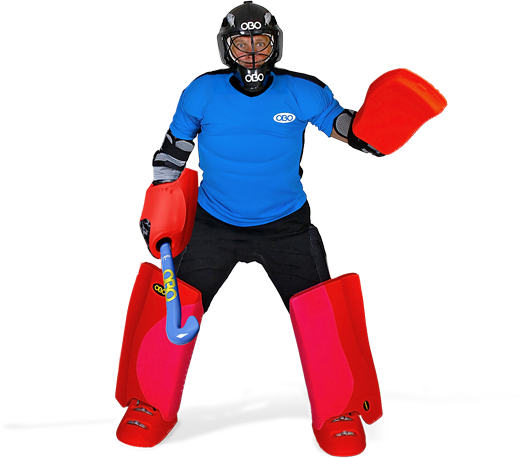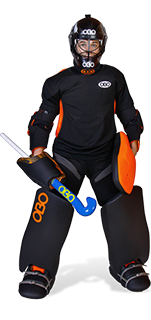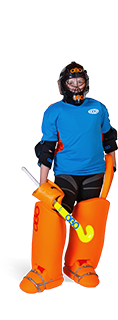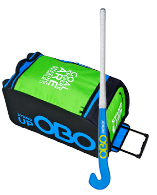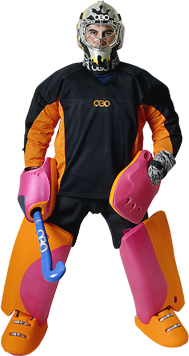KEEPERS RESOURCES

What to do after the shot
Now that you’ve made the low save (like a dive, or have purposefully gone down to block with a barrier) the hardest thing to deal with is getting back up and recovering in time for the secondary save. Similarly, if you end up on your back, after making a scrambled save, moving across goal, and end up losing your balance, then your situation is made even more tricky by the need to get strong in your stance within the time allowed to recover.
The burning question on your mind, is what to do next; unsure whether to cover shooting space, or take yourself out of the play for a recovery. Do you make the effort to get back up and try to get set? Or do you attempt to make a desperation save against the rebound shot?
With the ball potentially coming straight back into play, you have to have your wits about you; aware of what is going on around you, and able to make a dramatic reflex save if required. Your defenders can be extremely helpful in getting the ball out of the zone as the shooters attempt to score on the rebound, and you need to work with them, as well as communicating the dangers they aren’t attentive to.
Recovering from the save
Barrier saves are hard to recover from, even without the need for quickness; along with getting up from a save where you have ended up on the pitch. As with all saves, the best recovery is reversing how you made the movement in the first place; pushing up off the stick, getting up on your feet and then going back to your normal stance.
-
Bring your left leg in front of your right leg, planting firmly down on the ground with your left foot
-
Raise yourself up onto your right glove, ready to push up
-
Push yourself up in a single motion,
-
As you do that, bring your right leg underneath your left
-
Kneeling off your right knee, plant your right foot on the ground as you push from it to a standing position
-
Return to your ready stance
When pushing, make sure you get as much power as possible in order to get up in one go, otherwise you will struggle and waste precious time or get stranded.
Keep your eyes on the ball at all times, so you are aware of where it is and whether another shot is coming your way or not. You can keep your glove out in front of you at all times in case of a shot, which you can stop with the glove.
As you get better and stronger from practise, you can eliminate getting up off the knee and get up in a single motion instead.
When to recover
As the goalkeeper facing the shots, it is important to come to your own conclusions about when to recover in time; if you recover too early you may leave yourself vulnerable, whereas if you stay down for too long, you will leave yourself open to lifted shots.
Depending on how the play is developing, and your confidence in your own recovery speeds, you should recover for the next shot as it develops.
Pointers
When you recover depends on the situation and how the play has developed. If you can recover and it is best to do so, then get back up quickly, otherwise stay down and get ready to block another shot!
-
Once the ball is cleared from the zone and away from danger, you can get up again normally
-
If the ball rebounds to the top of the D, get up as quickly as possible using the recovery technique
Staying down
Sometimes the only thing you can do against the shot is to stay down. You don’t have enough time to recover, so the best thing is to remain down, allowing you to cover the low shot. You can attempt to get in the way of rebound opportunities, using your body to cover the shooting space, even putting your hand in front of the shot to cover more space. Rolling over onto your back can help you cover low on-pitch strikes using the snow angel desperation technique as explained later on.
The shooter’s priority here is to get the ball over or through you as quickly as possible. You can bank on their nervousness and desire to get the shot off as soon as possible, simply shooting straight into you.
Relying on your defenders
Some of us are blessed with good defenders who know our style of play and decision making in dealing with shots. By staying down on the play and letting our defenders deal with clearing the rebound, we can increase coverage of the bottom of the net, in case the attackers try to lift the ball or shoot at your prone frame as they attempt to get the ball out of the D.
You will generally not have time to recover, so letting your defenders do the job for you will help you in dealing with the situation.
Comments
Leave Your Comments Below















